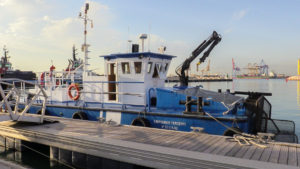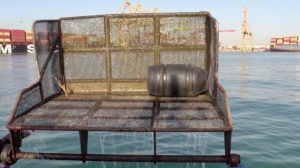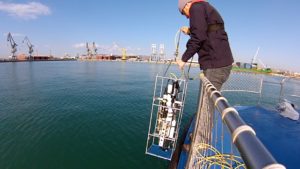
The Limpiamar boat travels every day through the interior waters of the docks to collect floating waste
The PAV manages water quality with waste removal, water analysis and hydrocarbon measurement
The quality of the water of the Port is optimal as shown by natural indicators such as the breeding of clotxinas
From Monday to Friday, early in the morning, the boat Limpiamar is set in motion, a “Pelicano” type boat that travels through all the interior waters of the Port of Valencia to collect any floating waste that may be on the water. This system, together with the analytical control that the Port Authority of Valencia (PAV) periodically carries out on the interior waters of the three ports and the measurement of the presence of hydrocarbons are the filters that serve to manage the control of the quality of the water.
The Limpiamar, a boat about ten meters long, is responsible for keeping the waters of the port clean thanks to the basket it has in the bow. Every day, it goes around each area and collects the objects it finds on the surface. The head of the environment at the PAV, Santiago López, explains that “we carry out daily monitoring and cleaning of the floating waste that comes from the sheet of water. This waste is collected by this boat, which has a basket in the bow and collects all the floating waste and deposits it in a special tank. This waste is taken out and managed by an authorized manager”.
Waste that is normally plastic, paper, wood or rubbish that may accidentally fall from the docks or arrive from outside the Port. But the Limpiamar also acts to collect large waste such as “wooden logs of 5 meters in length that pose a risk to the navigation of the boats,” says Santiago Lòpez, who adds that on some occasions have also been removed “bodies of dead cetaceans. In this case, a protocol is activated through 112, also notifying the Oceanogràfic and the University of Valencia to study the causes of death and the origin of these”.
The activity of the Limpiamar is constant and acts as one of the vacuum cleaners that we can have in our homes. “We go out from Monday to Friday and we are on duty 24 hours a day in contact with the emergency control centre to go in exceptional cases such as large logs that pose a danger to the navigation of the boats”, indicates Jesús Ferrández, skipper of the Limpiamar.
In addition to its daily role of monitoring the quality of the water, the Limpiamar also acts to remove floating objects from the old course of the River Túria, which connects to the Port. The boat serves as a complement to the anti-pollution barrier installed in this area, which allows the daily collection of floating waste from the stretch of the old riverbed between the Oceanogràfic and the shipyard bridge where various rainwater collectors in the city converge and those that reach the riverbed due to the effect of the wind, preventing them from reaching the port or the beaches adjacent to the port area of Pinedo and El Saler.

Optimal water quality
This permanent action of cleaning the water sheet is complemented by physical-chemical analysis and monitoring of the concentration of hydrocarbons. “Periodically we carry out a water quality control in the three ports following the water framework directive, the environmental quality control regulations and the ROM 5.1 which is a specific instrument of how the control of the water in the ports should be carried out. We carry out a control of the water column with parameters such as temperature, presence of hydrocarbons, chlorophylls or turbidity. In addition, we analyze chemical and heavy metal parameters both on the surface of the water and in the sediments that we collect from the bottom”, says the environmental manager of the PAV.
For Santiago López, “after 15 years of carrying out analytical control of water quality, we can ensure that it is optimal. There are natural indicators such as the breeding of clotxinas or Valencian oysters that show that the interior waters of the Port have an important concentration of nutrients and phytoplankton and, an optimum salinity for the growth and flavour of these molluscs”.


